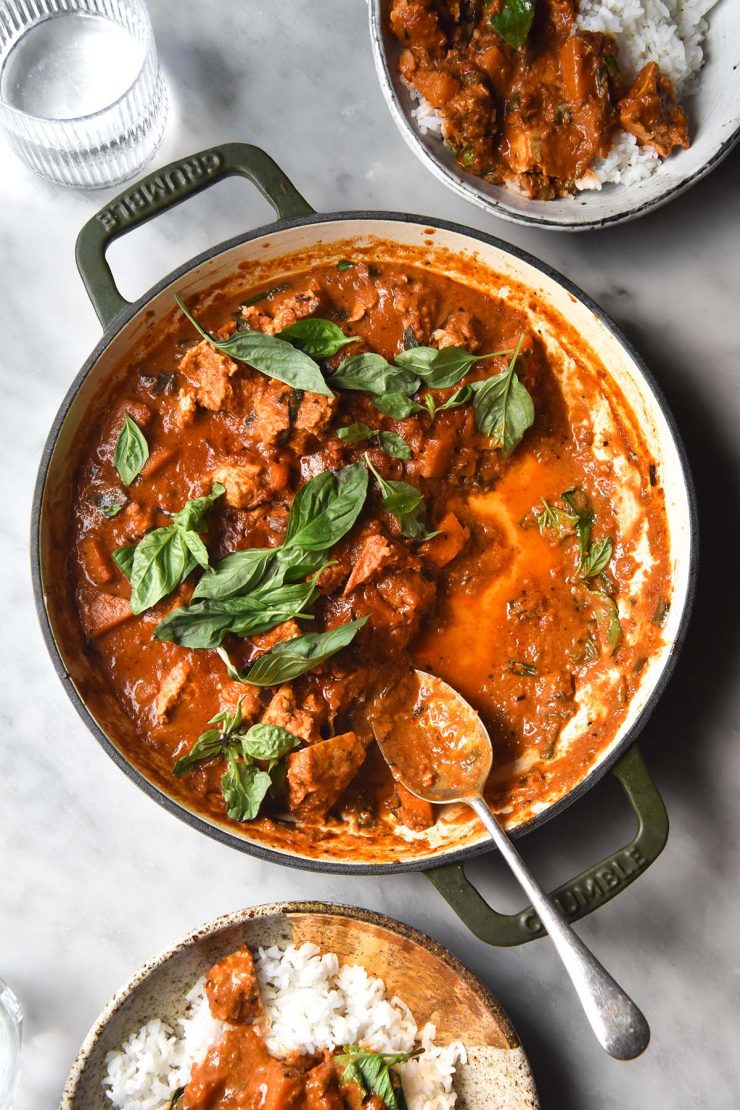
Whenever I get home from a trip I’m always inspired to develop low FODMAP recipes from that country. After my trip to Thailand, I posted a low FODMAP green Thai curry and Pad Thai in quick succession. But then the next trip comes along, and the cycle repeats. After my trip to America, it was gluten free bagels. After my Sicily trip, gluten free Arancini. So today I wanted to slow it down and post some recipes I started and never finished. Beginning, of course, with this low FODMAP Thai red curry.
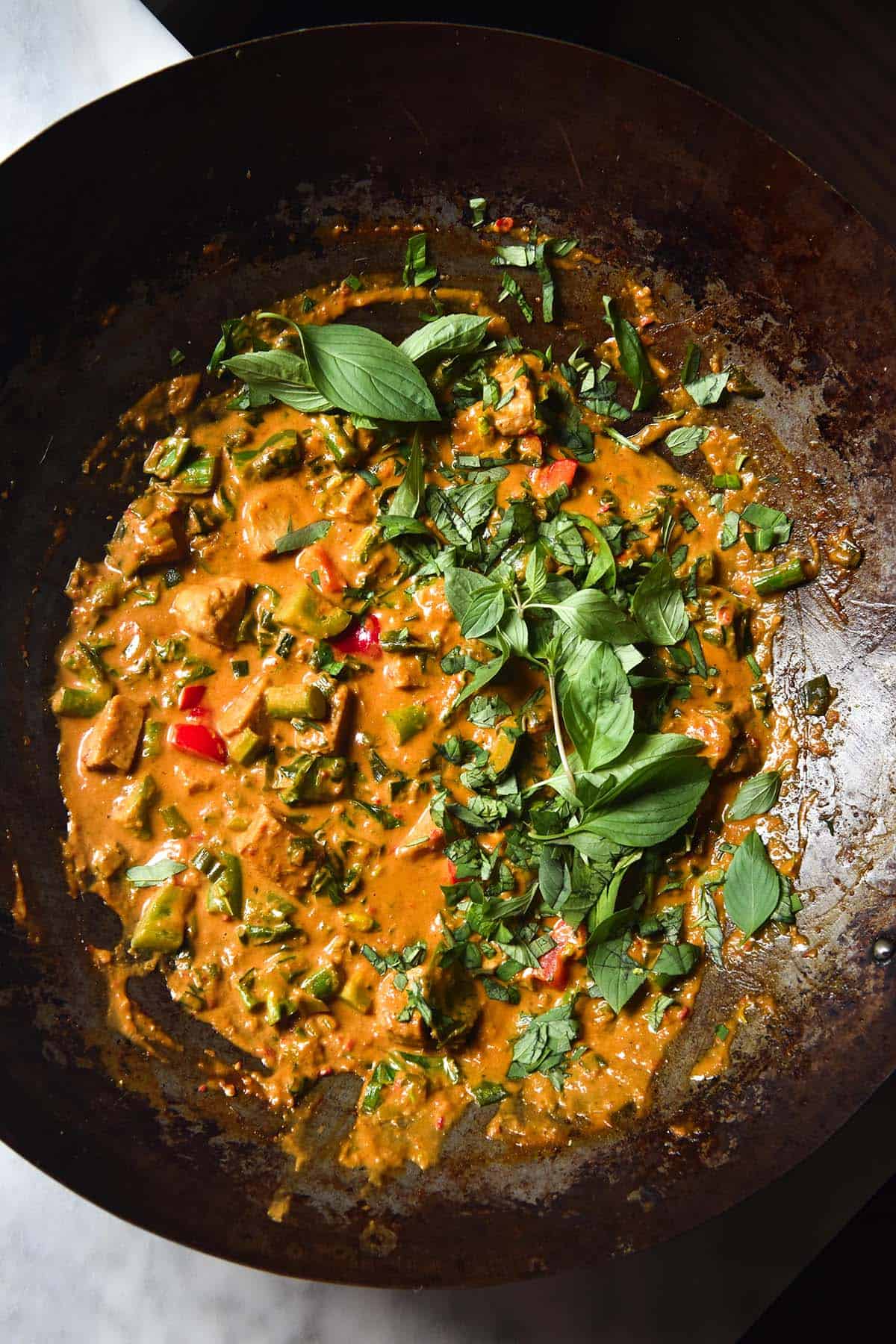
Low FODMAP Thai red curry
This curry uses a simple homemade curry paste. Because FODMAP most often means no garlic or onion, this paste is made without garlic or onion. I also use vegan shrimp paste, but you can use whatever you like to suit your dietaries.
The paste is a combination of red chillies, lemongrass, galangal or ginger, makrut lime or lime leaves, coriander roots, shrimp paste, dried cumin, paprika and coriander powder.
The curry is finished using spring onion greens for a hit of low FODMAP onion flavour. Coconut milk or cream and water provide the liquid base, and tofu is my protein of choice. I like to add pumpkin to bulk out the curry, but you can add whatever you prefer.
A few extra seasonings like vegan fish sauce and tamari are added for flavour. Finally, the curry is finished with a good squeeze of lime juice and Thai basil leaves. It’s a fragrant and delicious dish that everyone will love, irrespective of dietaries.
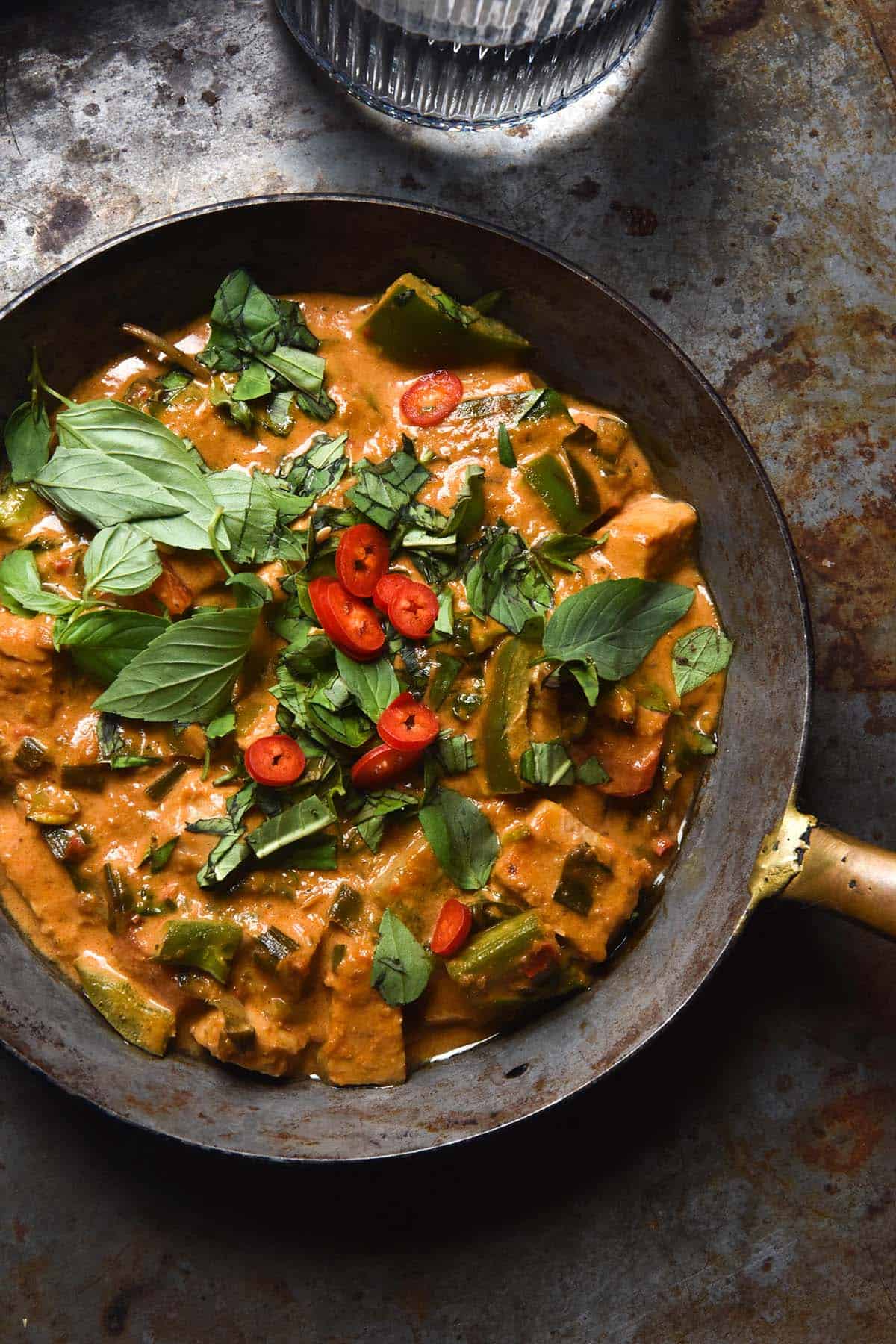
FODMAP notes for the curry paste
These thresholds are current as of July 2025. They will be periodically reviewed to ensure they remain up to date with the Monash app.
Pickled garlic is low FODMAP in serves of 3-29g per person. In serves of 29g or more, pickled garlic contains moderate amounts of fructose. Experiment and see what works for you. I have an easy recipe for pickled garlic if you can’t find it in the shops (homemade tastes better anyway).
Fresh red chilli is low FODMAP in 28g serves per person, which is approximately 1 medium chilli. In 33g serves, fresh red chillies contain moderate amounts of fructans. Personally, I am a chilli wuss anyway, so this curry paste uses significantly less chillies than regular pastes. You can use what works for you.
I use Vincent the Vegetarian brand of vegan shrimp paste. They don’t use onion or garlic in any of their products, so it’s a great option. I bought mine at KFL supermarket in Springvale, Melbourne. If you use regular shrimp paste, Monash says it is low FODMAP in 10g serves per person (approximately 2 teaspoons per person). They don’t currently list an upper threshold. FODMAP Friendly app lists shrimp paste as low FODMAP in serves of up to 100g per person.
Spring onion greens are low FODMAP in 75g serves and contain moderate amounts of fructose in serves exceeding 97g.
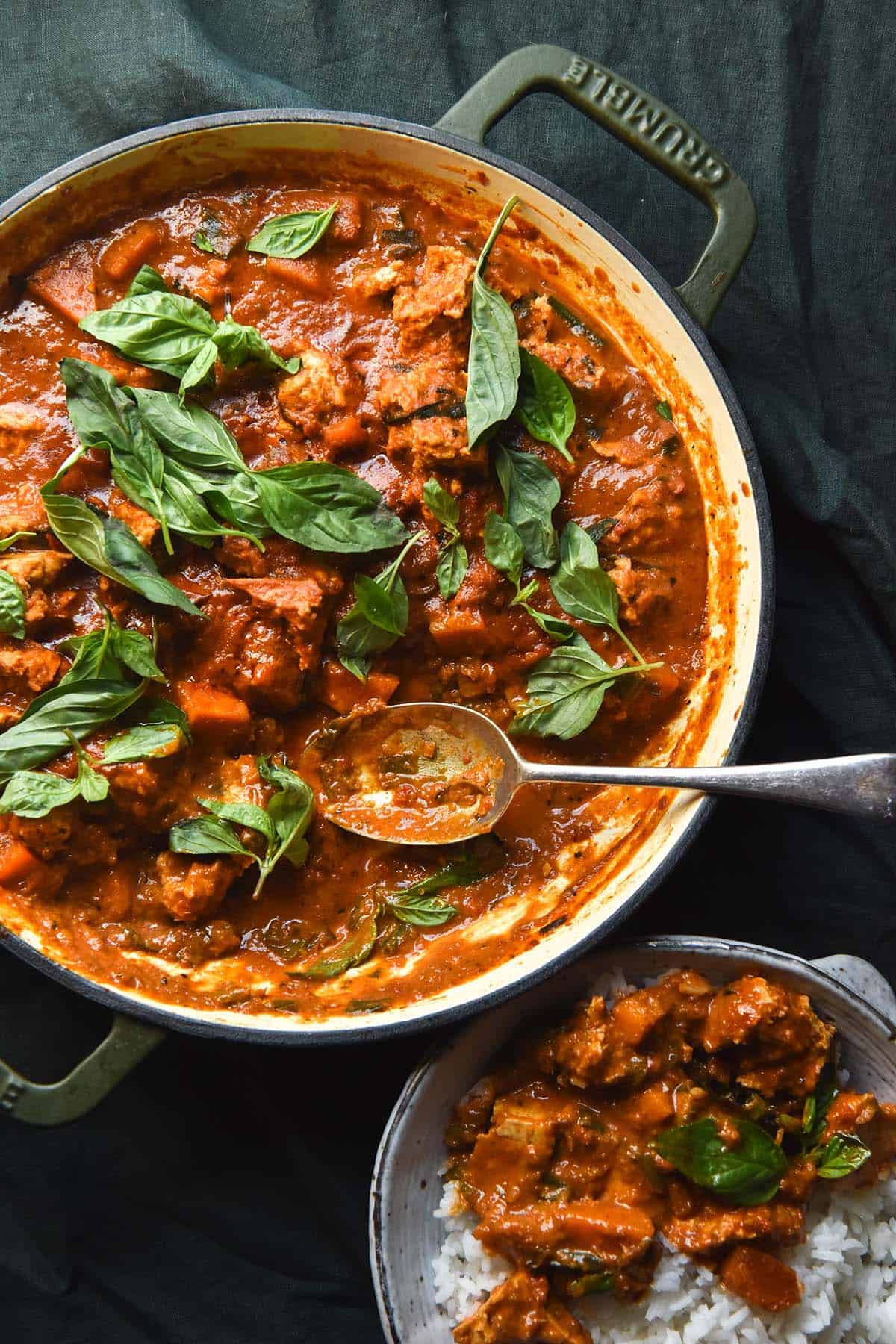
FODMAP notes for the Thai red curry
You can put whatever you like in the curry – tofu, fish, chicken, beef, whatever. I have no experience with using meats in curry, so I can’t offer any guidance as to cooking times or methods. Firm tofu is low FODMAP in serves of 170g per person.
Use a coconut milk or cream without any fillers, inulin or other fibres. Check the ingredients label – it should have only coconut and water listed as ingredients. Light coconut milk and full fat coconut cream are both low FODMAP in serves of up to 500g (provided they don’t contain inulin or fillers). Choose a brand with a high percentage of real coconut – I like Ayam brand.
The vegetables you use in the curry can be based on what you have on hand. Vegetables aren’t an authentic addition, as far as I can tell, but they do make a nice and filling dinner. I have used chopped pumpkin, pak choi and tofu – use what you have and what works for you. Just consider their FODMAP content if you choose to go rogue. Since I published this recipe, pumpkin has had it’s FODMAP threshold drastically reduced, so I would recommend using carrot or another low FODMAP vegetable instead.
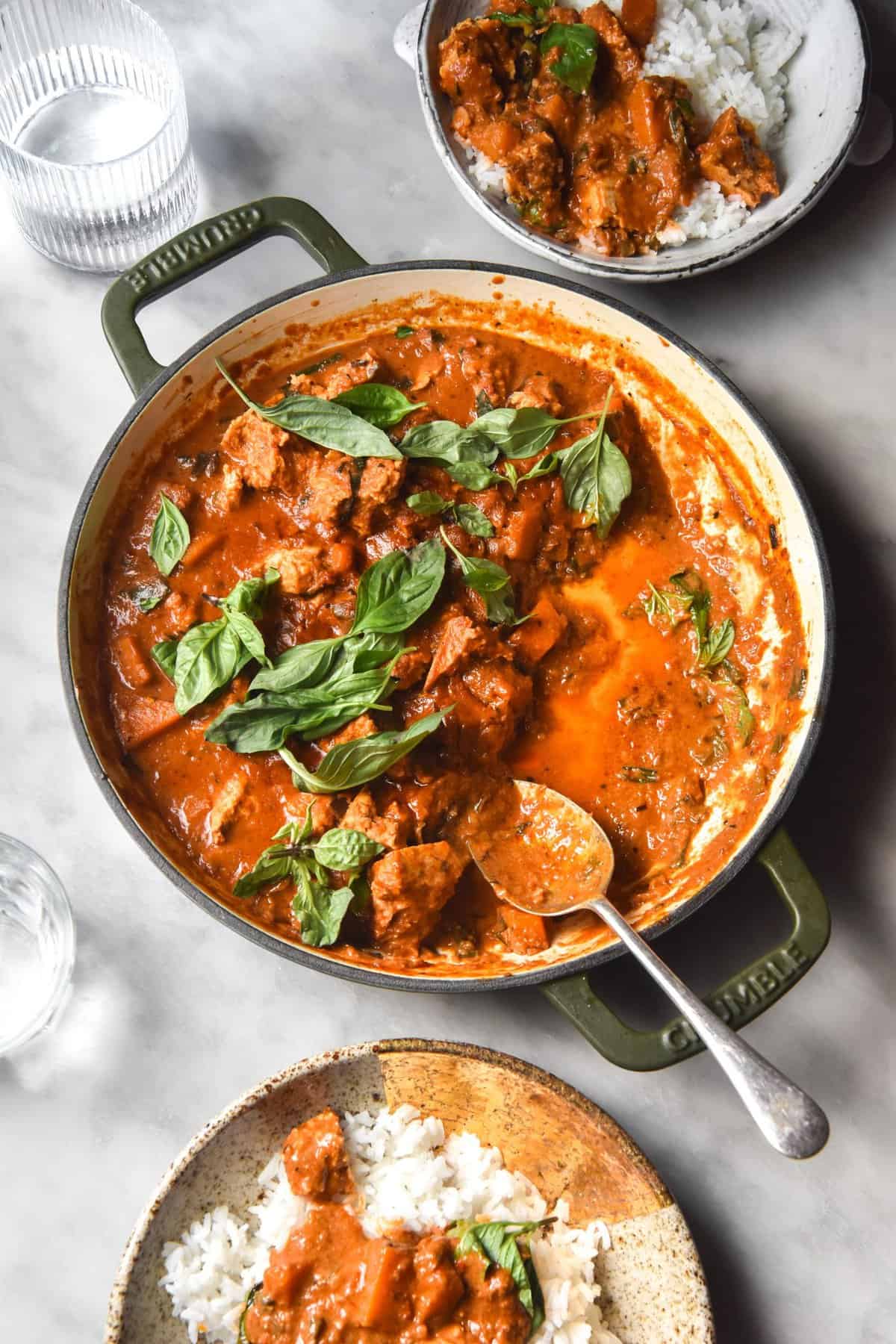
Adding flavour to your low FODMAP Thai red curry
Because we’re not using onion or garlic in their natural forms, we need to work on adding the flavour back into the curry. This can be done multiple ways (and I like to combine them all) but you can choose what is accessible to you and what you prefer.
- Spring onion greens. These are such an easy way to add that garlic and onion flavour back into a low FODMAP curry. Make sure you thoroughly wash them and chop them in relatively small pieces. Note that they have a FODMAP threshold of 97g or less.
- Loads of ginger. Even if you don’t like ginger, it adds a base note of flavour to a curry. I generally don’t find you can taste ‘ginger’ in a curry, so it just helps to develop the flavour.
- Asafoetida powder. This is the powder of a giant wild fennel that smells and tastes a bit like cooked onion and garlic. It’s very pungent and goes a long way. If you need to, make sure you buy a gluten free brand as it’s often cut with wheat flour.
- Pickled garlic. This is a new one for me, as it was only recently added to the Monash FODMAP app. I’m yet to fully determine how much flavour it brings but it’s garlic!!

More low FODMAP curry recipes
- Low FODMAP green Thai curry
- Low FODMAP vegetarian Indian style curry
- Gluten free Malai Kofta
- Homemade lactose free paneer in curry
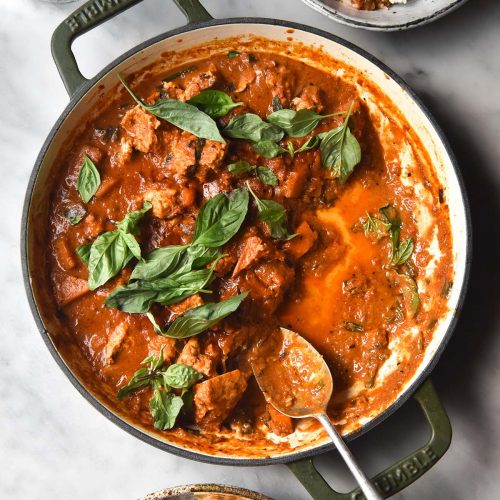
Low FODMAP Thai red curry
Ingredients
- 1 x quantity low FODMAP Thai red curry paste (recipe link in notes)
- 40-60 ml (2-3 tablespoons)* of neutral oil (I used vegetable)
- 1 bunch spring onion greens (50-75g per person) thoroughly washed and finely chopped
- 2-3 makrut lime leaves optional
- Water as necessary
- 1 x 400ml can light coconut milk or full fat coconut cream without inulin or added fibres
- 250 g Japanese or kent pumpkin chopped into small cubes (or potato or carrot for a lower FODMAP option)
- 20-40 ml (1-2 tablespoons)* gluten free soy sauce or Tamari, to taste
- 20-40 ml (1-2 tablespoons)* vegan fish sauce, to taste
- 5-20g (1-4 teaspoons) sugar to taste
- makrut lime zest to taste (optional)
- Seasoning to taste
- 400-500 g firm tofu torn into small chunks
- Bunch of Thai basil to finish
- Fresh lime juice to finish
Instructions
- Prepare the low FODMAP Thai red curry paste as per your taste preferences.
- Heat a large skillet or wok over a medium-low heat and add the oil. Once shimmering, add the spring onion greens and makrut lime leaves (whole) if you’re using them. Cook for 2-3 minutes or until softened and fragrant.
- Add the curry paste and cook for a few minutes until fragrant. Add a splash of water whenever necessary.
- Add the coconut milk and stir to combine. Allow to cook for a minute or two before adding the chopped pumpkin. Pop the lid on and cook for 5-10 minutes or until the pumpkin has softened (this will depend on how small you cut your pumpkin)
- Once the pumpkin has cooked, add the sauces and flavourings/seasoning. I recommend adding 1/2 at a time and tasting the curry to make sure it’s how you prefer it. Some brands of vegan fish sauce is more salty than others so it’s important to use these to taste. If you like a thinner curry, add extra water to suit.
- Once you’re happy with how the curry is tasting, add the tofu and cook until warmed through.
- Top the curry with Thai basil leaves and a generous squeeze of lime juice and serve with rice. Leftovers keep well in the fridge for a couple of days or can be frozen and defrosted.
Notes
- Here is the recipe for my low FODMAP Thai red curry paste.

No Comments